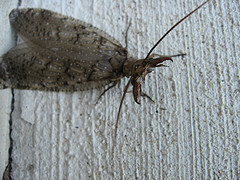This insect is probably the eastern Dobsonfly. The Latin name for this insect is Corydalus Cornutus.
As an adult, the Dobsonfly will measure approximately 2 inches in length. It is normally a brownish grey colour and has long grey wings that fold down over its back. Male Eastern Dobsonflies have two long jaws called mandibles that are about half its body length. The female Dobsonfly has smaller mandibles. The male's two mandibles will not hurt anyone. They are used for grasping a female Dobsonfly when they are mating. The bite of the female is painful.
The larva of the Dobsonfly is called a hellgrammite. For nearly most of their life these larvae will be found in fast moving parts of rivers and streams. This will be for up to three years. After mating, the female will lay her eggs on rocks or on branches near streams. From 100 up to 1,000 eggs will be laid with a whitish substance over them. The eggs look like bird droppings. This might protect them from various predators. Their main predators are fish. After the hellgrammites have hatched, they will either crawl into the water or drop into the water from the overhanging branch. They are not good swimmers, and mostly move by crawling. Their strong jaws are used to take their prey apart. They can also draw blood from humans.
When the hellgrammites are full sized, they will crawl out of the water and then pupate. This means they will form a cocoon. They will then crawl underneath a log or rock by the water and stay there for winter as a cocoon. When summer comes, the adult Dobsonfly will come out to mate. They will not eat anything and will only live for a couple of days. Eastern Dobsonflies will often be attracted to the lights at night time.
As an adult, the Dobsonfly will measure approximately 2 inches in length. It is normally a brownish grey colour and has long grey wings that fold down over its back. Male Eastern Dobsonflies have two long jaws called mandibles that are about half its body length. The female Dobsonfly has smaller mandibles. The male's two mandibles will not hurt anyone. They are used for grasping a female Dobsonfly when they are mating. The bite of the female is painful.
The larva of the Dobsonfly is called a hellgrammite. For nearly most of their life these larvae will be found in fast moving parts of rivers and streams. This will be for up to three years. After mating, the female will lay her eggs on rocks or on branches near streams. From 100 up to 1,000 eggs will be laid with a whitish substance over them. The eggs look like bird droppings. This might protect them from various predators. Their main predators are fish. After the hellgrammites have hatched, they will either crawl into the water or drop into the water from the overhanging branch. They are not good swimmers, and mostly move by crawling. Their strong jaws are used to take their prey apart. They can also draw blood from humans.
When the hellgrammites are full sized, they will crawl out of the water and then pupate. This means they will form a cocoon. They will then crawl underneath a log or rock by the water and stay there for winter as a cocoon. When summer comes, the adult Dobsonfly will come out to mate. They will not eat anything and will only live for a couple of days. Eastern Dobsonflies will often be attracted to the lights at night time.

